Orton C., Tyers P., Vince A. Pottery in archaeology
Подождите немного. Документ загружается.


230 Conclusion
But we should perhaps not ignore other factors in ceramics: the immediacy
of pottery; the message from the past at an everyday and sometimes intensely
personal level - who has not placed their fingers in the marks left by that
long-dead potter as he formed the jar, stopped and thought for a moment...?
Time's wheel runs back or stops
potter and clay endure.
Robert Browning, Rabbi ben Ezra, xxvii
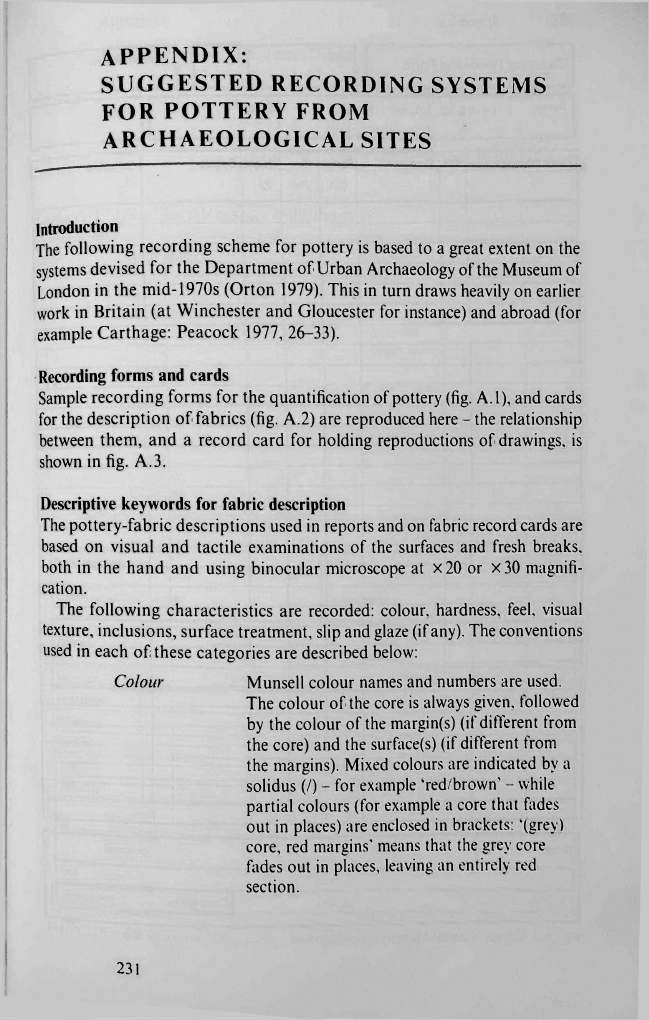
APPENDIX:
SUGGESTED RECORDING SYSTEMS
FOR POTTERY FROM
ARCHAEOLOGICAL SITES
Introduction
The following recording scheme for pottery is based to a great extent on the
systems devised for the Department of Urban Archaeology of the Museum of
London in the mid-1970s (Orton 1979). This in turn draws heavily on earlier
work in Britain (at Winchester and Gloucester for instance) and abroad (for
example Carthage: Peacock 1977, 26-33).
Recording forms and cards
Sample recording forms for the quantification of pottery
(fig. A. I),
and cards
for the description of fabrics (fig. A.2) are reproduced here - the relationship
between them, and a record card for holding reproductions of drawings, is
shown in fig. A.3.
Descriptive keywords for fabric description
The pottery-fabric descriptions used in reports and on fabric record cards are
based on visual and tactile examinations of the surfaces and fresh breaks,
both in the hand and using binocular microscope at x
20
or x 30 magnifi-
cation.
The following characteristics are recorded: colour, hardness, feel, visual
texture, inclusions, surface treatment, slip and glaze (if any). The conventions
used in each of these categories are described below:
Colour Munsell colour names and numbers are used.
The colour of the core is always given, followed
by the colour of the margin(s) (if different from
the core) and the surface(s) (if
different
from
the margins). Mixed colours are indicated by a
solidus (/) - for example 'red/brown' - while
partial colours (for example a core that fades
out in places) are enclosed in brackets: '(grey)
core, red margins' means that the grey core
fades out in places, leaving an entirely red
section.
231
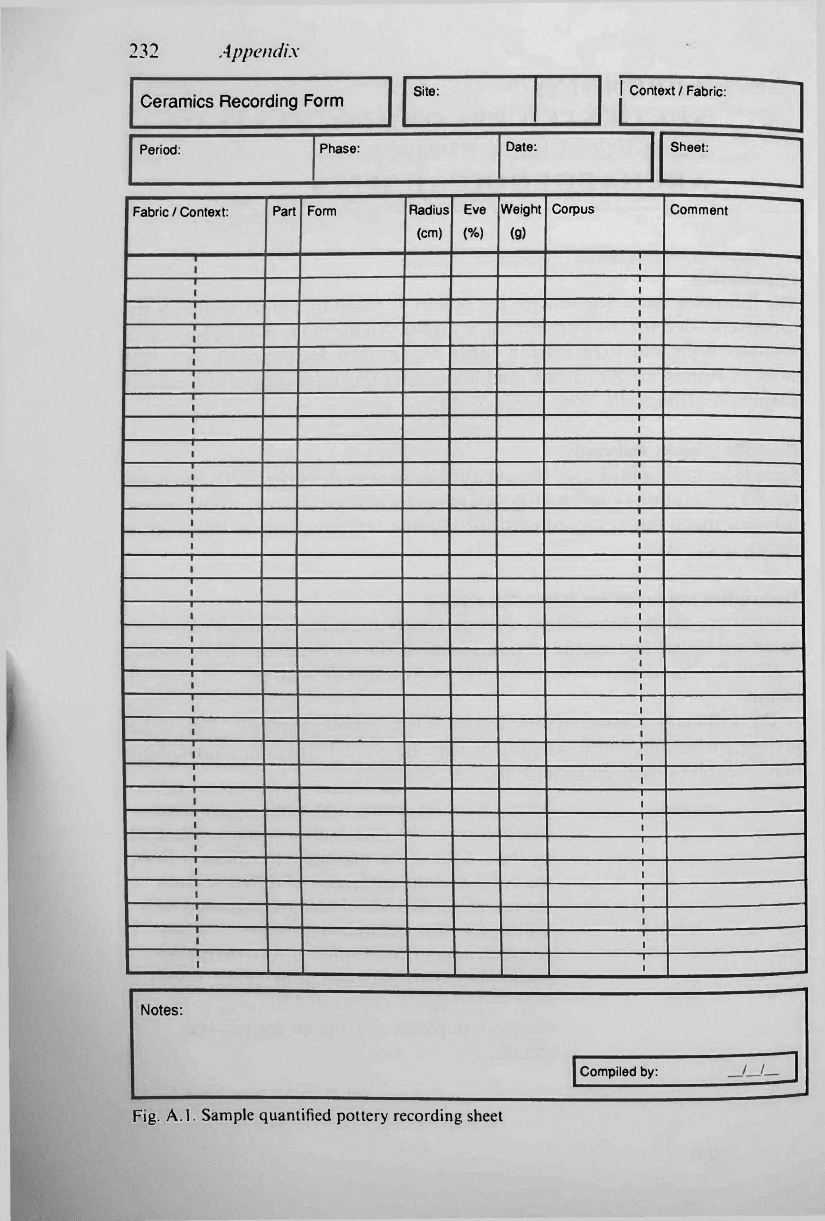
232 Appendix
Ceramics Recording Form
Site:
I Context/Fabric:
Period:
Phase:
Date:
Sheet:
Fabric / Context:
Part
Form
Radius
(cm)
Eve
(%)
Weight
(g)
Corpus
Comment
Notes:
Compiled by:
Fig. A.l. Sample quantified pottery recording sheet
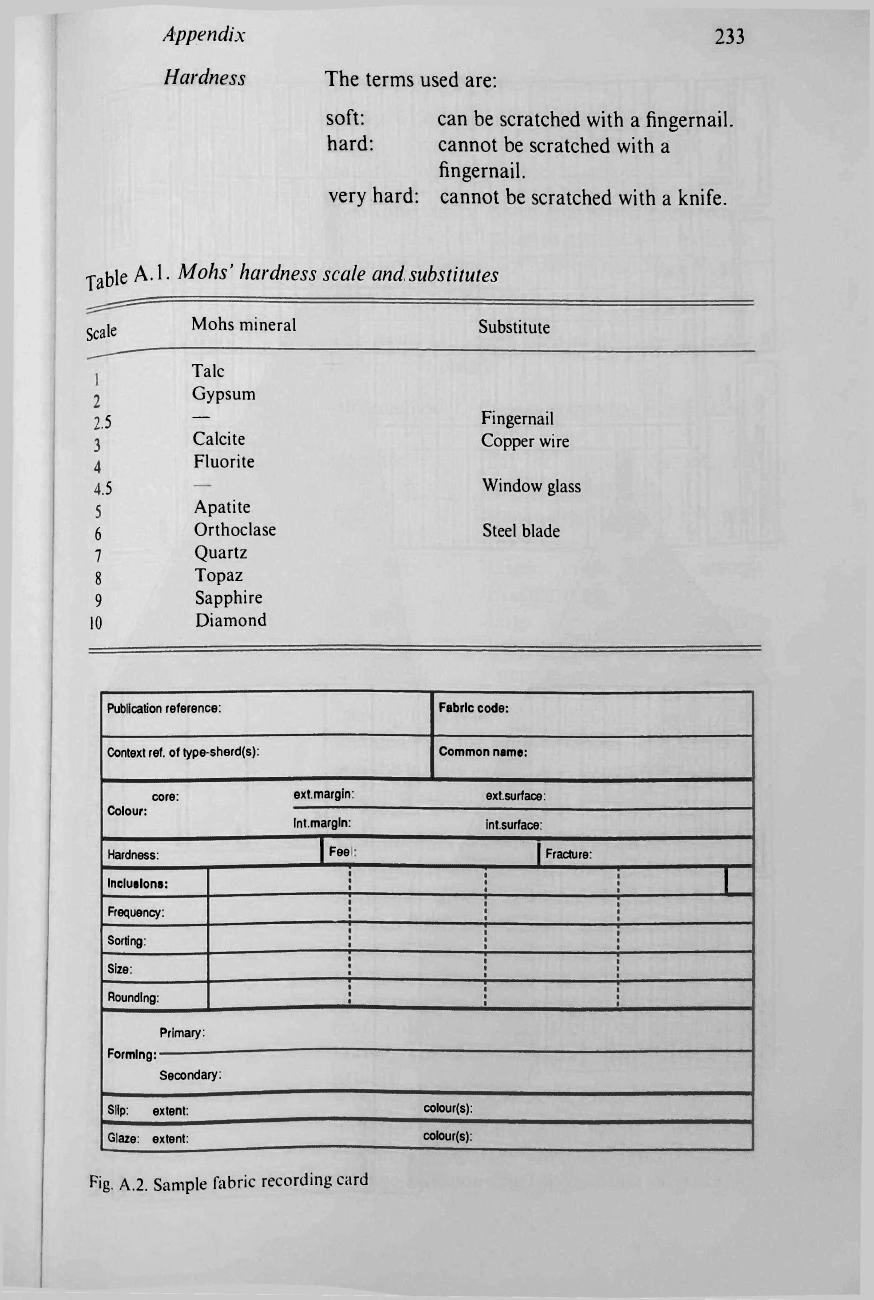
Appendix
233
Hardness The terms used are:
soft: can be scratched with a fingernail,
hard: cannot be scratched with a
fingernail.
very hard: cannot be scratched with a knife.
Table A-1- Mohs' hardness scale and substitutes
Scale
Mohs mineral
Substitute
Tale
Gypsum
2.5
VfajfgU
Fingernail
Calcite
Copper wire
Fluorite
4.5
Apatite
Window glass
6
Orthoclase
Steel blade
1
8
Quartz
Topaz
9
Sapphire
10
Diamond
Publication reference:
Fabric code:
Context ref.
of type-sherd(s):
Common name:
core:
Colour:
extmargin:
extsurface:
core:
Colour:
Int.margln:
intsurface:
Hardness:
| Fee
|
1
Fracture:
Inclusions:
1
Frequency:
Sorting:
Size:
Rounding:
Primary:
Forming:
Secondary:
Slip: extent:
colour(s):
Glaze: extent:
colour(s):
Pig. A.2. Sample fabric recording card
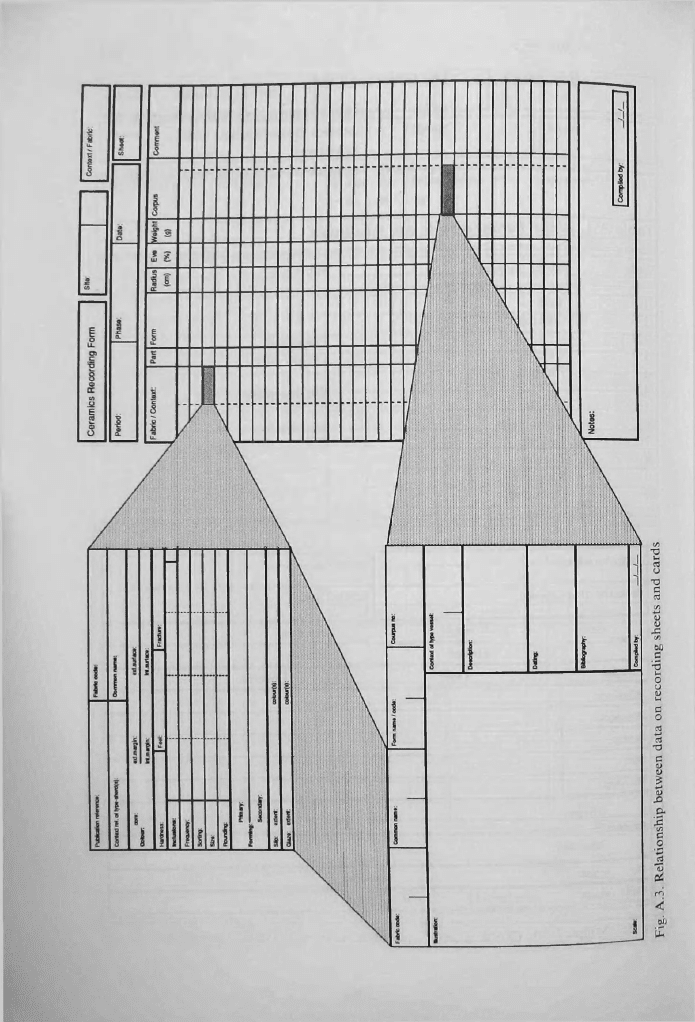
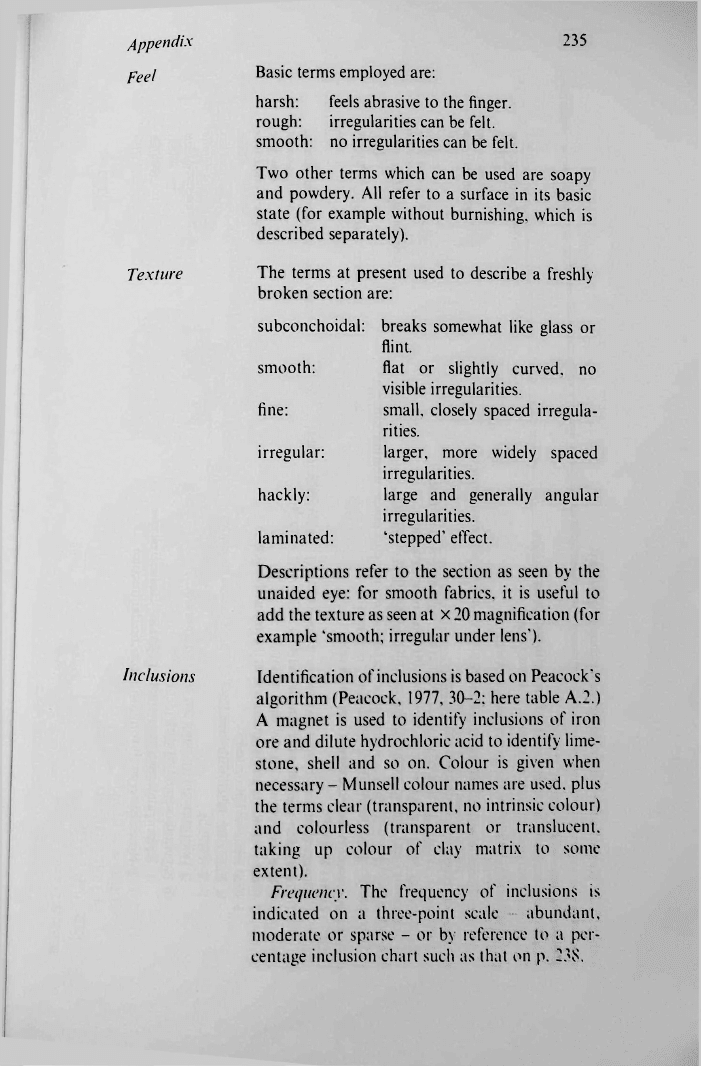
Appendix
Feel
Texture
Inclusions
235
Basic terms employed are:
harsh: feels abrasive to the finger,
rough: irregularities can be felt,
smooth: no irregularities can be felt.
Two other terms which can be used are soapy
and powdery. All refer to a surface in its basic
state (for example without burnishing, which is
described separately).
The terms at present used to describe a freshly
broken section are:
subconchoidal: breaks somewhat like glass or
flint
smooth:
flat or slightly curved, no
visible irregularities.
fine: small, closely spaced irregula-
rities.
irregular: larger, more widely spaced
irregularities.
hackly:
large and generally angular
irregularities.
laminated:
'stepped' effect.
Descriptions refer to the section as seen by the
unaided eye: for smooth fabrics, it is useful to
add the texture as seen at x 20 magnification (for
example 'smooth; irregular under lens').
Identification of inclusions is based on Peacock's
algorithm (Peacock, 1977, 30-2; here table A.2.)
A magnet is used to identify inclusions of iron
ore and dilute hydrochloric acid to identify lime-
stone, shell and so on. Colour is given when
necessary - Munsell colour names are used, plus
the terms clear (transparent, no intrinsic colour)
and colourless (transparent or translucent,
taking up colour of clay matrix to some
extent).
Frequency. The frequency of inclusions is
indicated on a three-point scale - abundant,
moderate or sparse - or by reference to a per-
centage inclusion chart such as that on p. 238.
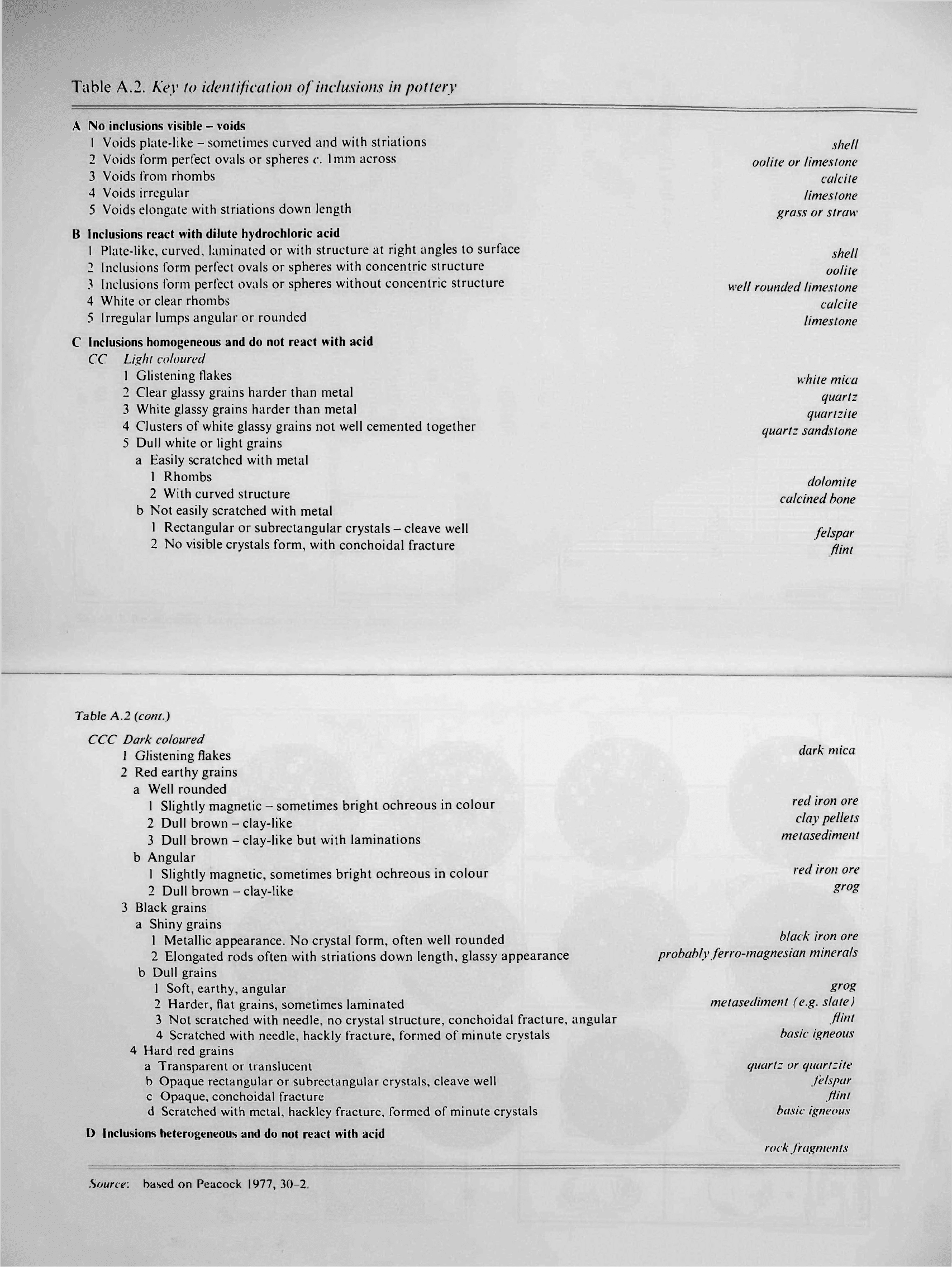
Table A.2. Key to identification of inclusions in pottery
A No inclusions visible - voids
1 Voids plate-like - sometimes curved and with striations
s
h
e
n
2 Voids form perfect ovals or spheres c. 1mm across oolite or limestone
3 Voids from rhombs calcite
4 Voids irregular limestone
5 Voids elongate with striations down length grass or straw
B Inclusions react with dilute hydrochloric acid
1 Plate-like, curved, laminated or with structure at right angles to surface
5
/j
e
//
2 Inclusions form perfect ovals or spheres with concentric structure oolite
3 Inclusions form perfect ovals or spheres without concentric structure
we
n
roun
ded
limestone
4 White or clear rhombs calcite
5 Irregular lumps angular or rounded limestone
C Inclusions homogeneous and do not react with acid
CC Light
coloured
1 Glistening flakes
w
hite mica
2 Clear glassy grains harder than metal quartz
3 White glassy grains harder than metal quartzite
4 Clusters of white glassy grains not well cemented together quartz
sandstone
5 Dull white or light grains
a Easily scratched with metal
1 Rhombs dolomite
2 With curved structure calcined bone
b Not easily scratched with metal
1 Rectangular or subreetangular crystals - cleave well felspar
2 No visible crystals form, with conchoidal fracture fn
nt
Table
A.2
(cone.)
CCC Dark
coloufed
1 Glistening flakes dark mica
2 Red earthy grains
a Well rounded
1 Slightly magnetic - sometimes bright ochreous in colour
re<
^
iron ore
2 Dull brown-clay-like
clay
pellets
3 Dull brown - clay-like but with laminations metasediment
b Angular
1 Slightly magnetic, sometimes bright ochreous in colour
iron ore
2 Dull brqwn
-jdatfj&ke
8
ro
8
3 Black grains
a Shiny grains
1 Metallic appearance. No crystal form, often well rounded black iron ore
2 Elongated rods often with striations down length, glassy appearance probably ferro-magnesian
minerals
b Dull grains
1 Soft, earthy, angular S
r
°8
2 Harder, flat grains, sometimes laminated metasediment (e.g. slate)
3 Not scratched with needle, no crystal structure, conchoidal fracture, angular flint
4 Scratched with needle, hackly fracture, formed of minute crystals basic
igneous
4 Hard red grains
a Transparent or translucent quartz or
quartzite
b Opaque rectangular or subreetangular crystals, cleave well felspar
c Opaque, conchoidal fracture flint
d Scratched with metal, hackley fracture, formed of minute crystals
basic igneous
D Inclusions heterogeneous and do not react with acid
rock fragments
Source: based on Peacock 1977, 30-2.
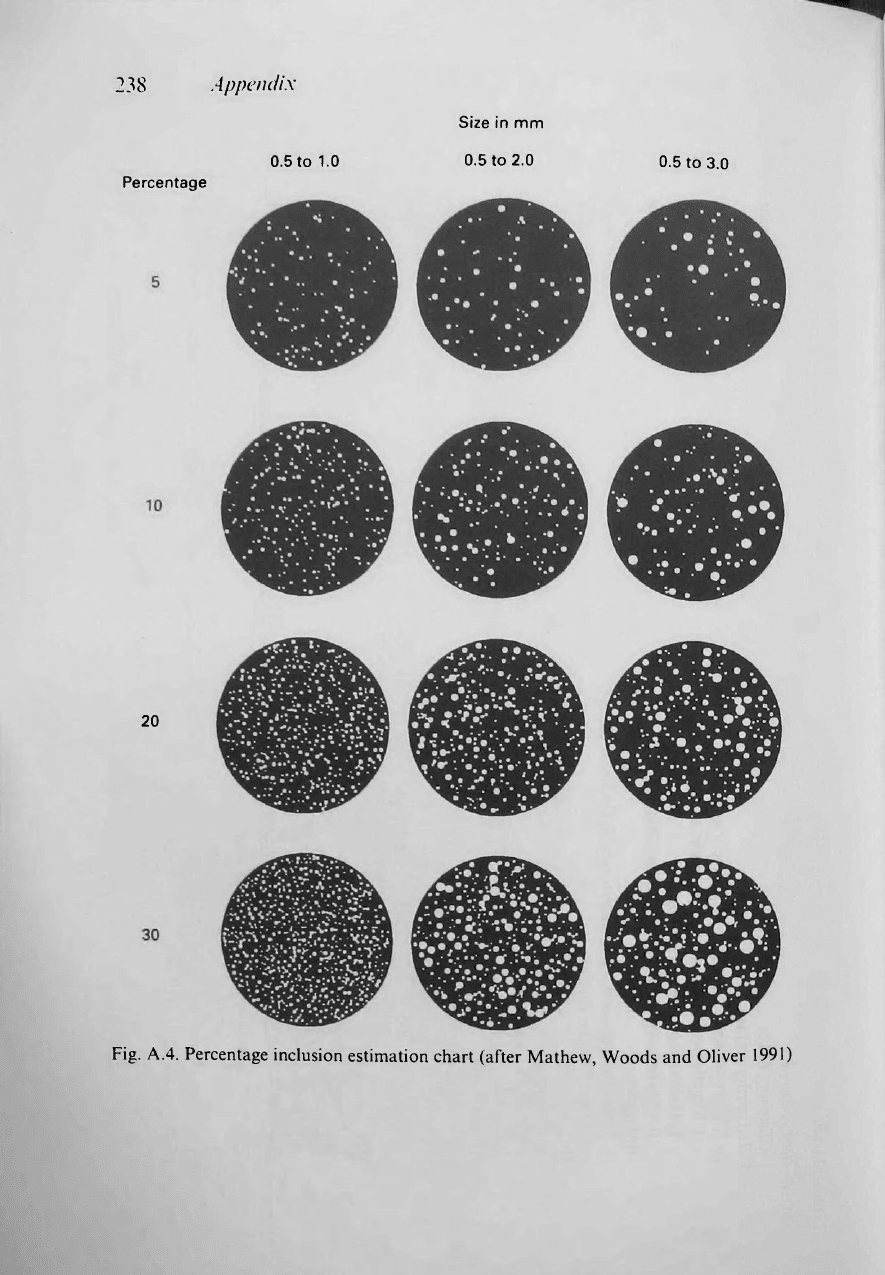
238 Appendix
Size in mm
0.5 to 1.0 0.5 to 2.0 0,5 to 3.0
Percentage
20
Fig. A.4. Percentage inclusion estimation chart (after Mathew,
Woods and Oliver 1991)

Appendix
239
POWERS' SCALE OF ROUNDNESS
Class
lJJÜI
a
3
4
S
6
Very
Angular
Angular
Sub-
Angular
Sub-
Rounded
Rounded
Well
Rounded
High
Sphericity
0
®
S
©
Low
Sphericity
<M
a
1
Fig. A.5. Sphericity/roundness estimation chart (from Barraclough 1992)
Scale for Pebble Sorting
m
ipfefeg
ÉM
mmmm
MSätS
mmsm
ÜÜ
1MSMSÏS
tMWp
Very Poor
Poor
Fair
Good
Very Good
2
3
4
5
Fig. A.6. Inclusion sorting chart (from Barraclough 1992)
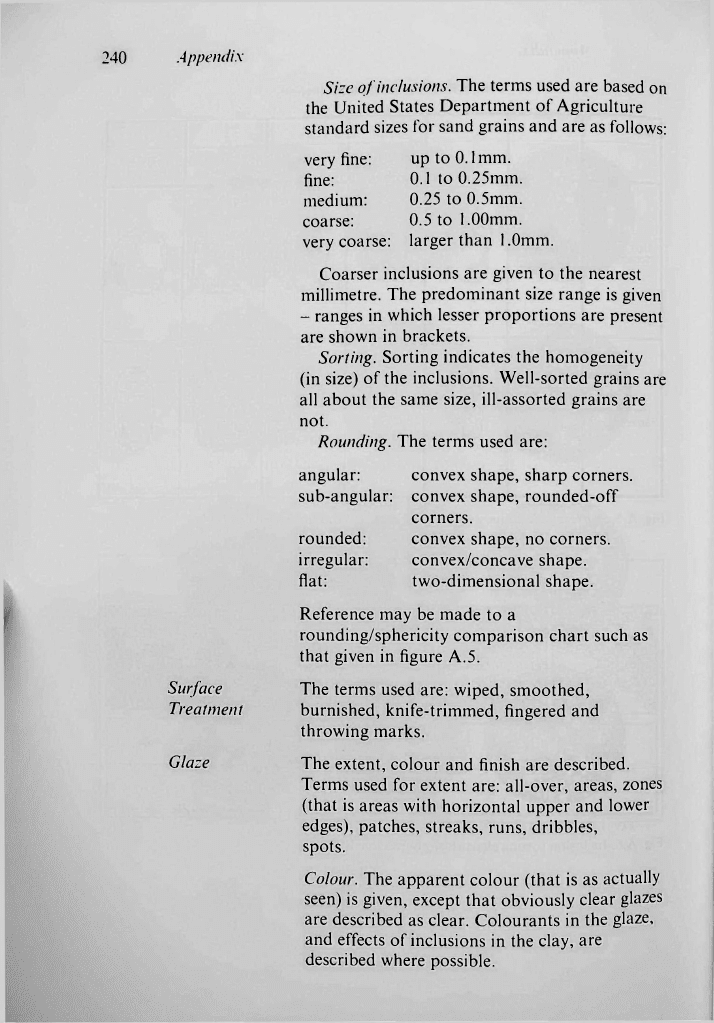
240
Appendix
Size of inclusions. The terms used are based on
the United States Department of Agriculture
standard sizes for sand grains and are as follows:
very fine: up to 0.1mm.
fine: 0.1 to 0.25mm.
medium: 0.25 to 0.5mm.
coarse: 0.5 to 1.00mm.
very coarse: larger than 1.0mm.
Coarser inclusions are given to the nearest
millimetre. The predominant size range is given
- ranges in which lesser proportions are present
are shown in brackets.
Sorting. Sorting indicates the homogeneity
(in size) of the inclusions. Well-sorted grains are
all about the same size, ill-assorted grains are
not.
Rounding. The terms used are:
angular: convex shape, sharp corners,
sub-angular: convex shape, rounded-off
corners.
rounded: convex shape, no corners,
irregular: convex/concave shape,
flat: two-dimensional shape.
Reference may be made to a
rounding/sphericity comparison chart such as
that given in figure A.5.
Surface The terms used are: wiped, smoothed,
Treatment burnished, knife-trimmed, fingered and
throwing marks.
Glaze The extent, colour and finish are described.
Terms used for extent are: all-over, areas, zones
(that is areas with horizontal upper and lower
edges), patches, streaks, runs, dribbles,
spots.
Colour. The apparent colour (that is as actually
seen) is given, except that obviously clear glazes
are described as clear. Colourants in the glaze,
and effects of inclusions in the clay, are
described where possible.
